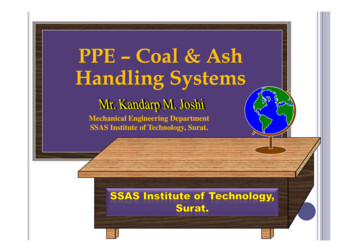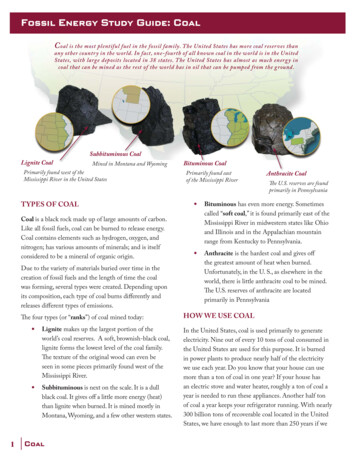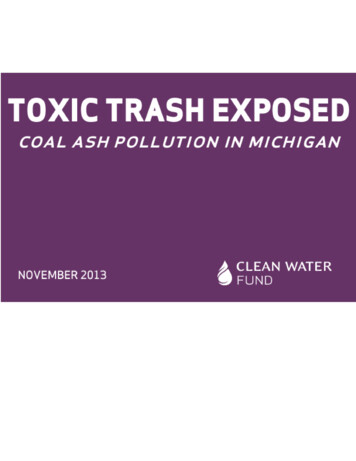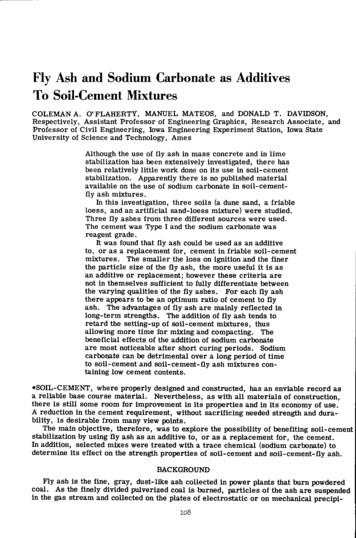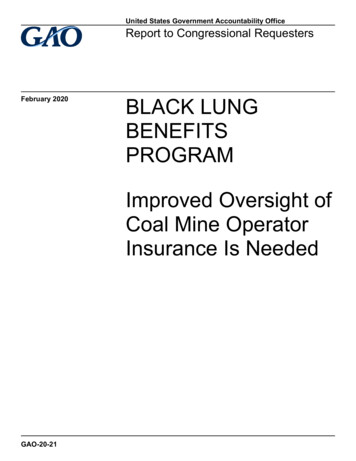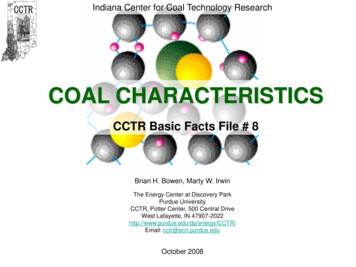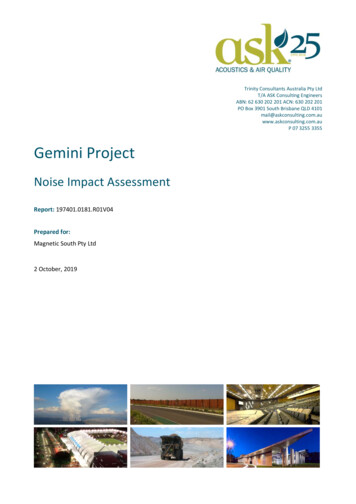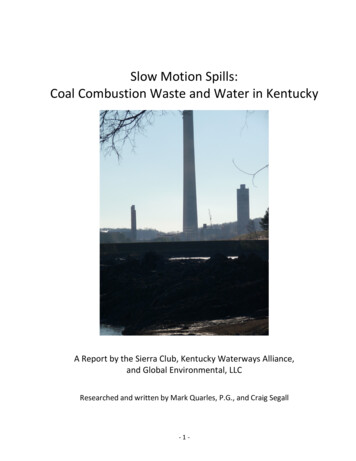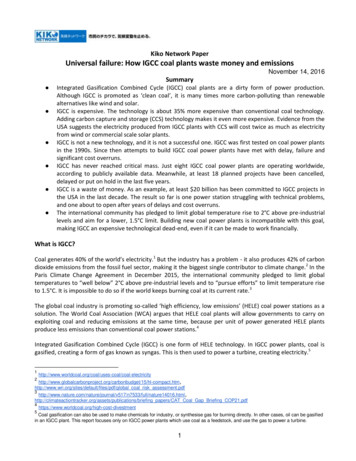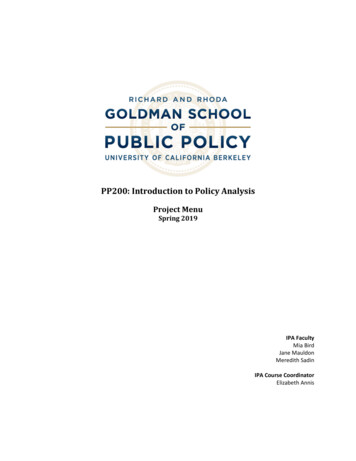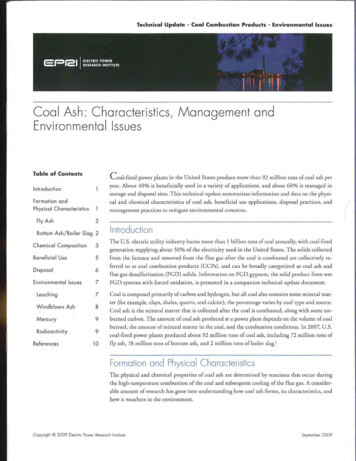
Transcription
Technical Update - Coal Combustion Products - Environmental IssuesCoal Ash: Characteristics, Management andEnvironmental IssuesTable of CantentsCoal-fired power plants in the U nited States produce more than 92 million tons of coa l ash peryear. About 40% is beneficially used in a variety of applications, and about 60 % is managed inIntroductionstorage and disposal sites. This technical update summarizes information and data on the physi Formation andcal and chemical characteristics of coal ash , beneficial use applications, disposal practices, andPhysical Characteristicsmanagement practicesFly Ash(Q(mitigate environmental concerns.2Bottom Ash/Boi le r Slag 2IntroductionThe U.S. electric utility industry burns more than 1 billion tons of coal annually, with coal-firedChemical Composition3Benefic ial Use5Disposal6Environmental Issues7FGD systems with forced oxidation, is presented in a companion technical update document.leach ing7Coal is composed primarily of carbon and hydrogen, but all coal also contains some mineral mat Windblown Ash8Mercury9Radioactivity9References10generation supplying about 50% of the electricity used in the United States. The solids collectedfrom the furnace and removed from the flue gas after the coal is combusted are collectively re ferred to as coal combustion products (CCPs), and can be broadly categorized as coal ash andflue gas desulfurization (FG D ) solids. Information on FGD gypsum, the solid product from wetter (for example, clays, shales, quartz , and calcite); the percentage varies by coal type and source.Coal ash is the mineral maner that is collected after the coa l is combusted, along with some un burned carbon. T he amount of coal ash produced at a power plant depends on the volume of coalburned, the amount of mineral marrer in the coal, and the combusrion conditions. In 2007, U.S.coal-fired power plants produced about 92 million tons of coal ash, including 72 million tons offly ash, 18 million tons of bottom ash, and 2 million tons of boiler slag. 1Formation and Physical CharacteristicsThe physical and chemical propenies of coa l ash are determined by reactions thar occ ur duringthe high-temperamre combustion of the coal and subsequent cooling of the flue gas. A consider able amount of research has gone into understanding how coal ash forms, its characteristics, andhow it weathers in the environment.Copyright 2009 Electric Power Research InstituteSeptember 2009
Fly AshFly ash refers to the lightweight particles that travel with the flue gas as it exits (he furnaceand moves away from the high -temperature combustion zone. Power plams are equipped withparticulate collection devices, either e1ec([osr3ric precipitators (ESPs) or baghouses, designed toremove nearly all of t he Fly ash from the flue gas prior to the stack to prevent it fro m being emit (cd to the atmosphere (Figu re 1). An ESP uses eiecnically charged wires and plates to capture thefly ash; baghouses use fabric filters, similar to vacuum cleaner bags. Dry fly ash collected in (heESP or baghouse is then either pneumatically conveyed to a hopper or storage silo (dry manage ment) , or mixed with watet and sluiced through a series of pipes CO an on-site impoundment (wetmanagement) .(BottomAsh/SlagCollectionFly AshCollectionFG D GypsumCollectionStackFigure 1. Typical power plant layout showing location of fly ash and bottom ash coffecfion.Fly ash is composedFly ash particles are co mposed mainly of amorphous or glassy alum inosi licates. However, themainly of amorphousparticles also contain some crystalline compounds that either pass through the co mbustion zoneunchanged or are formed at hi gh temperatures. Elements such as arsen ic and selenium that be or glassy aluminosili cates Fly ash particlesare typically silt-sizedspheres, ranging from1 to 100 microns indiameter.come volatile at hi gh temperatures, preferentially condense on the sur face of the ash particles asthe flue gas cools.Fly ash particles are typically spherical in shape, either solid or with vesicles (F igure 2). A smallpercentage are thin-walled hollow particles called cenospheres. The particles are fine-grained,typically silt-sized, ranging from 1 to 100 microns in diameter, with median par ticle diameter of20 to 25 microns. 2 Fly ash is usually tan to dark gray in color.Bottom Ash/Boiler SlagBottom ash co nsists of heavie r particles that falltothe bottom of the furnace (see Figure 1).Bottom ash is also com posed primarily of amorphous or glassy alu minosilicate materials derivedfrom the melted mineral phases. Most bottom ash is produced in dry-bottom boilers, where theash cools in a dry state, Boi ler slag is a t ype of bottom ash collected in wet-bottom boilers (slag tap or cyclone furnaces, whi ch opera te at very high temperatures), where the molten particles arecooled in a water qu ench.2Cool Ash: Characteristics, Management and Environmental Issues
Bottom ash is coarserthan fly ash, with asandy texture andparticles ranging fromabout 0.1 mm to 50mm in diameter.Figure 2. Scanning electron micrographs of fly ash. (a) Typical spherical morphology of glassy particles.(b) A large hallow sphere formed when entrapped gas expanded during thermal decomposition of calciumcarbonate (CaC03 ). (c) A particle etched with hydrofluoric acid fo remove surface glass and reveal a shell ofinterlocking mullite crystals. (d) A typical magnetic spinel mineral (magnetile) separated from ash after removalof encapsulating glass. (e) A fractured ash particle containing numerous vesicles. (f) The accumulation of tinygranules of inorganic oxides, crystals, and coalesced ash on the surface of a larger particle.Whether collected from dry-bottom or wet-bottom boilers, bottom ash is usually mixed withwater and conveyed away from the furnace in a sluice pipe. It- is transported either co a dewateringbin or to an Oil-site impoundment.Bottom ash is coa rser than fly ash, with a sandy texture and particles ranging from about 0.1 mmto50 mm in diameter. Bo[[o111 ash from dry-bottom boilers is genera lly dull black and porOllS inappearance. It typically has the consistency of coarse sand to gravel and higher carbon contentt han fly ash. Boiler slag is black and angu lar, and has a smooth, glassy appearance.The properties of fly ash and bottom ash make them useful for a variety of construct ion applica tions. Table 1 lists ranges fo r some of the important geotechnical properties of fly ash and bottomash.The properties of flyTable 1. Typical ranges for geotechnical properties of fly ash and bottom ash. 3ash and bottom ashmake them useful forSpecific GravityIbs/k3a variety of construc Bulk Density (compocted),tion applications.Optimum Moisture Content, %Hydraulic Conductivity, cm/sPorosityI of Internal Friction,2.1 - 2.92.3 - 3.065 - 11065-11010 -3510'-10'12 - 2610.1 10030.40 - 0.500.25 - 0.4025 -4035 - 45Chemica l CompositionThe chem ical composition of coal ash is determined primarily by the chemistry of the sourcecoal and the combustion process. Because ash is derived from the inorganic minerals in [he coal,such as quartz, feldspars, clays, and metal oxides, the major elemental composition of coal ash isCoal Ash: Characteristics, Management and Environmental Issues3(
similar to th e compositio n of a wide variety of rocks in the Earth 's crust (Figure 3) . Oxides ofsili con, alu minum, iron, and calcium comprise more than 90% of the mineral component of typicalfly ash (Figure 3). Minor constituents such as magnesium, pocassi um , sodium, titanium, andsulfur account for about 8% of the mineral component, whi le [face constituems such as arsenic,cadmium, lead, mercury, and selenium, together make up less than 1% of the [otal composition.Table 2 provides the typical range of major and trace constituents concent rations in fly ash andbottom ash, along with the range for rock and soil for comparison.100%90%Because ash is derivedfrom the inorganicminerals in the coal,the major elementalc0: w80%070%060%a.E50%/composition of coalUash is similar to a 40%C30%wide variety of rocks.Oxides of silicon,aluminum, iron, andcalcium make up morethan 90% of the min·eral component of flyro'0vu:;;" 20%10%0%Volcanic Ashash; trace constituentsSi . AIFeShaleFly AshBottom AshCa . Other Major Elements . Minor Elements . Trace Elementscollectively make upless than 1 percent.Figure 3. Elemental composifion For boHom ash, Fly ash, shale, and volcanic ash. Median values For ash areFrom EPRI database3, and For rock are From Taylor and Lifche (1980) and Hem (1992).5Fly ash also contai ns a variable amount of unburned ca rbon , depending on the combus tion con ditions. Unburned carb on is often measured by a laboratory test called loss-on-ignition (LOl ).LOI values can range from less than 1% to more than 20%.The relative calcium, iron, and su lfur coments of fly ash influence its fundamenta l chemicalproperties and reactivity. Subbituminous and lignite coal ashes typically contain relatively highconcentrations or calcium, with concentrations exceeding 15% (expressed as CaO ), and producealka li ne solutions (pH 11 - 12) on contact with water. Bituminous coal ashes generally comainmuch less calcium. and yield slightly acid ictoslighdy alkaline solutions (p H 5 - 10) on co ntactw ith water.The chemical composi tion of coal ash can change as power plams change fuels or add new airemissions controls to prevent rel eases to the atmosphere. iO Examples of ai r emissions controls thatcan impact fly ash composition include the use of ammonia-based syste ms to co ntrol NO x' pow dered activated carbon injection to control mercury, and sodium-based sorbents to control S03·Examples of fuel changes include blending of different coal types ) and co-firing of biomass with4Cool Ash: Choracteristics, Management and Environmenfollssues
coal. EPRI maintains active research programs to eva lu ate the impacts of changes in emissionscontrols on the env ironmemal and engineering characteristics of the ash. li onTable 2. Range (lOth percentile - 90th percentile) in bulk composition of fly ash, bollom ash, rock, and soil.70,000 - 140,00059,000 - 130,0009,800 - 96,0007,400 - 150,0005,700 - 150,0006,000 - 83,0001,500 - 62,000Iron, mg/kg34,000 - 130,00040,000 - 160,0008,800 - 95,0007,000 - 50,000Silicon, mg/kg230,000 - 390,000Aluminum, mg/kgCalcium, mg/kg160,000 - 270,000160,000 - 280,00057,000 - 380,000Magnesium, mg/kg3,900 - 23,0003,400- 17,000700 - 56,0001,000 - 15,000Potassium, mg/kg6,200 - 21 ,0004,600 - 18,0004,000 - 45 ,0004,500 - 25 ,000Sodium, mg/ kg1,700- 17,0001,600 - 11 ,000900 - 34,0001,000 - 20,000Sulfur, mg/ kg1,900 -34,000BDl- 15,000200 - 42 ,000840 - 1,500nlanium, mg/ kg4,300 - 9,0004, 100 - 7,200200 - 5,4001,000 - 5,000BDl- 1.3Antimony. mg/kgBDl-16All BOl0.08 - I.BArsenic, mg!kg22 - 2602.6- 210.50-142.0- 12Barium, mg/ kg380-5 1003BO - 360067 - 1,400200- 1,000BDl - 2.02.2 - 260.21 - 140.10 - 4.4120-1000BDl- 3350.2 - 220BDl-70Cadmium, mg/kgBDl - 3.7All BDl0.5 - 3.6BDl- 0.5Chromium, mg/kg27 - 30051 - 11001.9 - 31015 - 100Copper, mg/kg62 - 22039 - 12010- 1205.0 - 50Lead, mg/kg21 - 2308 1 - 533.8 - 44BDl- 30Manganese, mg/kg91 -70085 - 890175 - 1400100- 1,0000.01 - 0.5 1BDl- 0.070.1 - 2.00.02-0.19All BDlBeryllium, mg/kgBoron, mg/kgMercury, mg/kgIn 2007, 32 milliontons of fly osh and9.0 million tons ofbottom ash and boilerslag were beneficiallyused. The primary usefor fly ash was as areplacement for port·land cement in makingconcrete.15,000 - 100,000Molybdenum, mg/ kg9.0 - 603.8 - 271.0 - 16Nickel, mg/ kg47 - 23039 - 4402.0 - 2205 -30Selenium, mg/ kg1.8 - 1880l- 4 20 60- 4.9BDl- 0.75Strantium, mg/ kg270 - 3100270 - 200061 - 89020 - 500Thallium, mg/ kgBDl - 45All BDl0.1 - 1.80.20 - 0.70Uranium, mg/kgBDl - 19BDl- 160.84 - 431.2 - 3.9Vanadium, mg/kgBDl - 360BDl- 25019 - 33020-150Zinc,63 - 68016 - 37025 -14022 -99BDL - Below Detection Limit* Sou rce for most fly ash and bottom ash data is EPRI CP-INFO Database:! , Beryllium, thallium, mercury (bot tom ash only) and boron (bottom ash only) are from the EPRI PISCES Dotabase 6** Source for rock dolo is US Geological Survey National Geochemical database,}* * * Source for most soils data is Shacklelle and Boerngen (1984)8; cadmium and thallium dolo are fromSmilh el 0112005)9Beneficial UseThe physical and chem ical propenies of coal ash make it suitable for many construction andgeotechnica l uses, In 2007. 32 million tons of fly ash were beneficially used. representing 44%of the tota l fly ash produced ' Similarly, 7-3 million tons of bottom ash (4 0%) and 1 7 millionshort tons of boiler sla g (80%) were used. Figure 4 shows {he amounts of fly ash used in variousapplicati ons.Cool Ash: Choracteri5 tic5, Managemenl and Environmen/ol155ue55
oConcreteStructuralFillsCementWaste5011Road BaseMineStabilization Reclamation StabilizationOtherFigure 4. Beneficial uses of coal fly ash. Data ore from the 2007 ACAA survey.'In 2007, the use of flyThe primary use for n y ash is as an ingred iem in concrete. Fly ash act as a pozzolan. a siliceouslash to replace cementaluminous material that develops cememitious properties when combined with calcium hydrox in concrete yielded en ide and water. Fly ash can be used as a direct rcplacemem for portland cement in concrete, andergy savings equivalentto the annual energyuse by over a half mil lion households, andreduced CO2 emissionsequivalent to removingover 1.5 million carsfrom the roadhas been used in a wide variety of concrete applications in the U nited States fo r more than 60years. The use of fl y ash can significamly improve many concrete qualities. for exampl e, strength ,permeability, and resistance ro a lkali silicate react ivity. Standard specification ASTM CGIS es tablishes the physical and chemical requirements of fly ash for use in concrete.l.fIn addition to improving the quality of concrete, the use of fly ash greatly reduces the energy useand CO 2 emissions associated with the production of concrete. In 2007, use of fly ash in concreteresu lted in an estimated 55 trillion Btu in energy savings, and 10 million tons in avo ided CO 2emissions. 15 These numbers are equivalent to the annua l energy use for over 600,000 householdsand removal of 1.7 million cars from the road, respectively. Other benefits of using as h includeconservation of virgin materials such as limestone used in cemem production. and reduced needfor disposal sites.In addition to conc rete, applications that use more than 1 million tons per year of fl y ash arcstructural fills, cement production. waste stabi lization, and mine reclamation. T he primary usesfor the coarser bottom ash and boiler sla g are for st ructural fi lls and road base materials, as blast ing gritlroofing granules, and for snow and ice traction control.US EPA actively promotes coal ash use under the Coal Combustion Partnership Program (C2P2),and has set a goal of 50% utilization by 2011. 16 The Federal Highway Administration providestechnical gu idance on the use and benefits of fly ash for highway co nstruction projects. 17Disposa lCoal ash that is not beneficially used is placed in landfills and impoundments. About 60% ofdisposed fly ash is managed dry in landfills, and 40% is managed wet in impoundments. There6Cool Ash: Characte ristics, M anogement and Environmental Issues
is a long-term trend toward increased use of dry management practices. III I !.!Dry fl y ash is typ ica lly loaded on trucks, wettedtoprevent dusting, and then cransponcdtoadedicated landfill facility. The landfill may be located on or off the power plant property. Wet managed fly ash is typica ll y sluiced to an on-site impoundment or se ries ofimpoundmems, wherethe fly ash seulestoCOthe bonom of the ponds. In some cases, t reatment chemicals may be addedthe ash pond co improve setrling, remove dissolved consritucms, or control pH. The settled ashsolids may either be dredged for beneficial use or for disposal, or may be left in place.Ash managemenr sites vary in age, size, and design. In most cases, the sites are operated understate-issued permits that specify applicable requirements for sit ing criteria, engi neering controls(for example, liners, leachate coll ectio n, caps, slopes, and runoff control), groundwater monitor ing, site closure, corrective action, and financial assurance. A study by US EPA and US Depart ment of Energy (DOE) published in 2006 found that regulatory and engineering control s fornew or expanded units permitted between 1994 and 2004 had tightened considerably, establish ing engineering cont rols and groundwater monitoring as standard practice,III For example, 55 of56 units assessed in that study employed engineered liners. with the only exception being onelandfill that managed only borrom ash.A study performed byIn 1993 and again in 2000, fo llowing several years of study, the US EPA published regulatoryUS DOE and US EPAdeterminations that coal ash and orher combustion products did not warrant regulation as a haz found that nearly allardous waste. 2U ,21 Disposal is currently regulated under non-hazardous provisions by individualnew CCP disposal unitsstates. Tn 2009, US EPA is agai n evaluating the appropriate fede ral role in regulating disposal of(55 of 56 units) stud coal combustion products.ied between 1994 and2004 employed linersEnviro nmenta l Issuesto control leachateLeachingrelease.One of the primary environmenral concerns at large storage and disposal sites is leaching andrelease of trace constituents to groundwater and surface water. Extensive testing has shown thatcoal ash rarely, if eve r. exceeds hazardous waste criteria contained in the the Tox icity Character istic Leaching Procedure (TCLP) promulgated under th e Resource Conservation and RecoveryAct.Laboratory studies have demonsuated that the leaching process is complex and depends on anumb er of factors, primarily chemical speciation of the constituent. solution pH . and availabilityof the constituent for leachin g. Availability for leaching depends on whether the element resideson the surface of the as h particle, in the outer glass hull, or within the interior glass matrix (seeFigute 2).In add ition. subsequent chemical imeractions and secondary mineral formation can furthermodify leaching characteristics of the ash. For example. because arsenic typically condenses onthe su rface of the ny ash particle. it may initially be available for leaching. However, the pres ence of calcium in rhe ash can limit the release of dissolved arsenic by fo rm ation of calcium arsenic precipitates. 22 Weathering and formation of iron hydroxide compounds can also servetosequester arseni c. Detailed leaching stud ies under controlled cond itions are used to elucidate[he mechanisms controll in g constituent relea se and provide the best indication of the long-termpotential for release and env ironmemal risk.While lab ora cory studies are used to define long-term leaching mechanisms, field studi es provideCoal Ash: Chorocteri5tic5, Monogement ond Environmenfal155ue57
1.E .02 1.E.011.EtOO'" E 1.E·01c·0. 1.E-.Q2 01.E·03u1.1.1.H,TIPbCoSbCrCuCdNiSeBaAsvMoBFigure 5. Field leachate concentrations for coal ash disposal sites. Bars show 10th percentile to 90th percentile,and diamond shows median. Source: EPRI CP-INFO Database. 3Coal ash rarely, if ever,the best information on leachate quality under actual environmental conditions. In 2006, EPRI,exceeds hazardouswith support from the US DOE, completed an extensive characterization offield leachates at overwaste criteria con 30 coal combustion product di sposal faci lities (Figure 5).23 This study provides the mosr compre tained in the the ToxicityCharacteristic leachinghensive database avai lable for ash leachate characteristics represemarive of typical environmentalconditions at disposal sites. The data in Figure 5 represent initial concentrations in the manage ment facility, nor the concentratio n that the public is exposed to; these data can be used as inputProcedure (TClP). Whileto infilnation and groundwater transport models to assess the risk of contamination to a receptor,laboratory studies areeither a drinking wate r well or su rface water body, and to develop the best management methodsused to understandto prevent or mitigate those risks.leaching mechanisms,Leachate runoff and infiltralion to groundwater can be controlled by a va ri ety of sta ndard en field studies providegineering practices employed at disposal facilities. Depending on site-specific conditions, thesethe best information onpractices may include use of liners, leachate collection systems, diversion ditches, caps, and veg leachate quality underetation. Monitoring networks are used to ensure the performance of the engineering controls inactual environmentalprotecting groundwater and surface water resources.conditions.Windblown AshBecause of its fine-grained texture, dry fly ash is susceptible to blowing under windy condirions.Studies of the potential health effects associated with ash dust have largely focused on powerplant workers, for whom exposure[Qdusty conditions is much more common than for the gen eral public. While direct inhalation of fly ash or any respirable dust shou ld be avoided, researchhas shown that worke r exposure to ash dust during normal power plant operation does nor resultin exposures above health criteria ?4.25Standard precautions such as dust masks are recommendedwhen working in high-dust environments at power plants. At disposal si tes, w indblown ash isgenerally controll ed by periodic wetting of open ash areas, and by coveri ng inactive areas withbottom ash, soi l, or vegetation.8Coal Ash: Characteristics, Management and Environmental Issues
MercuryResearch by US EPA,EPRI, and others hasall shown that mercu·ry is stable on fly ashat ambient tempera Mercury is an element of significant environmental interest because of its wxicity and occurrencein lakes and rivers. The median mercury concentration in coal is 0.11 mg/kg, and 80% of coalsamples conrain less [han 0.25 mg/kg. 26 Information collected by the US EPA in the late 1990sindicated that in the United States about 40% of the mercury in coal was captured by the fly ashand lor the then existing S02 control, and 60% was released to the atmosphere P The amount ofmercury captured at any particular plant was found to depend on a number of factors, includingtures, with very littlecoal type, coal chlorine content, particulate collection device, NO x control, and flue gas desul potential for leachingfurization systems.or volatilization.Mercury in fly ash generally ranges from about 0 .05 mg/kg up to about 2 mg/kg, with typicalconcentrations between 0.1 mg/kg and 0 .5 mg/kg. One of the leading approaches to further re duce mercury emissions from power plants is injection of activated carbon into the flue gas. Themercury sorbs onto the carbon, which is then captured with the fly ash in the ESP or baghouse.Although the mercury and carbon contem in rhe fly ash are increased by this process, research byUS EPA, EPRl, and others, has consistently shown that the carbon-bound mercury is very stableon the fly ash at ambient tcmperamres, with very low potential for leaching orvolatilization. 13 2x ,29Similarly, concrete containi ng fly ash exhibits very iiule mercury release and does not present asignificant risk to the public. 30 ,31 High-temperature fly ash uses, such as use in cement kilns andhot-mix asphalt, may release mercury from fl y ash to the air due to volatilization.Radioactivity"Radioactive elementsCoal contains naturally occurring radioactive constituents, such as uranium and thorium andin coal and fly ashtheir decay products. Uranium and thorium are each typically present in coal at concentrationsshould not be sourcesof 1 to 4 mg/kg. 32 These constituents are captured by the fly ash following combustion of theof alarm. The vastcoal. Any radon gas present in the coal is lost to stack emissions,majority of coal andAlthough the radionuclides are enriched in the fly ash in comparison to rhe coal itself, the USthe majority of fly ashGeological Survey determined that the average radionuclide concentrations in ash are withinare not significantlyenriched in radioactiveelements, or in asso productS\Medicine .ciated radioactivity,I OtherX-rays .compared to soil orrocks."-US GeologicalSurveyInternalRadonTerrestrialNatural SourcesManmade SourcesFigure 6. Distribution of background radiation sources comprising the total annual overage radiation dose inthe United States. 32,33Cool Ash: Characteristics, Manogement and Environmental Issues9(
the range of concentrations found in other geologic materials, such as granite and sha leY Back ground radiation exposure(0the U.S. popu lation is about 360 mrems/yr. with natura l sources,primarily geologic mater ials and cosm ic rays, accouming for about 82% of that tota l (Figu re6)Y',B Man-made sources account for the remaining 18% of total exposure, with X-rays beingthe largest single source,In a worst case evaluation, exposuretoan outdoor wor ker at an ash storage faci li ty (8 hrs/dayfor 225 days/yr) was estimated as 8 mrerns/yr, or only about 2.3% of background exposure.}}Similar results have been fo und in exam ining potential for radioactiv ity exposure to concretemade with a high proportion of fl y ash " Research by US EPA, US Geological Survey, EPR!, andothers has shown that expos ure to rad iation from coal ash or concrete products made with fly ashdoes not rep resent a sign ifica nt heahh ris k.ReferencesI. 2007 Coal Combustion Product (CCP) Production and Use Survey Results. Ametica n Coa l AshAssociation, 2008 , http://www.acaa-usa.org/.2. Coal Ash Disposal Manual: Third Ed ition. EPR!, Pa lo Alto, CA: 1995. TR-104137.3. CP-INFO Database. EPR!: August 5, 2009.4. Taylor, H.E. and Litche, F.E., 1980. Chemical Composition ofMt. St. Helens Volcanic Ash. Geo physical Research Lwers, Vol. 7, No. 11 , pp. 949-952.5. Hem, J.D., 1992. Study and Interpretation ofthe Chemical Characteristics ofNatural Water, USGeological Survey Water Supply Paper 2254. 3rd Ed.6. PISCES Database. EPR!: August 5, 2009.7. Geochemistry of Rock Samples from the National Geochemical Database. US Geological Survey:2008. http://rin.eLusgs.gov/metadata/ngdbrock.htm l.8. Shack lcttc, H. and J. Boerngen, 1984. Element Concentrations in Soils and Other Surficial Materi als ofthe Conterminous United States, US Geological Survey Professional Paper 1270.9. Smith, D.; Cannon, W.; Woodruff. L.; Garrett, R.; Klassen, R.; Kilburn.H .; Goldhaber, M.; Morrison,J., 2005.J.; Horron , J.;King,Major- and Trace-Element Concentrations in Soils fromTwo Continental-Scale Transects ofthe United States and Canada. US Geo logical Survey Open FileRep ort 2005-1253.10. Impact ofAir Emissions Controls on Coal Combustion Products. EPR!, Palo Alto, CA: 2008 .1015544.11 . Impacts ofSodium-Based Reagents on Coal Combustion Product Characteristics and Performance,EPR!, Palo Alto, CA: 2009. Report in prepa ration.12. Efficts ofAmmonia on Trace Element Leachingfrom Coal Fly Ash. EPR!, Palo Alto, CA: 2005.1010063.13. Mercury in Coal Combustion Products. EPRI, Palo Alto, CA: 2005. 1010061.14. ASTM Standard C618, Specification for Coal Fly Ash and Raw or Calcined Natural Pozzolan forUse as a MineralAdmixture in Portland Cement Concrete. ASTM International, West Conshohock en, PA. http://www,astm,org.10Cool Ash: Charocteristics, Manogement and Environmental Issues
15. Environmental Benefits ofUsing Coal Combustion Products. EPRl, Palo Alto, CA: 2009. Reportin preparation.16. Coal Combustion Product Partnership rep).usEPA; http: //ww w.epa.gov/waste/partner ships/c2p2/index.h[JTI .17. Fly Ash Facts for Highway Engineers. US Departmem of Transportation Federal Highway Ad ministra rion: 2003. FHWA-lF-03-0 19.18. Coal Combustion Waste Management at Landfills and Surfoce Impoundments: 1994-2004. USDOE and US EPA: 2006. DOE/PI-0004 ANL-EVS/06-4.19. Coal Combustion By-Products and Low-Volume Wastes Comanagement Survey. EPRI, Palo Alto,CA: 1997. TR-108369.20. Final Regulatory Determination on Four Lmoge-Volum e Wastes from the Combustion of Coal byElectric Utility Power Plants. Federal Register, 58 Fed. Reg. 42466, Aug. 9, 1993.2 1. Notice a/Regulatory Determination on Wastes from the Combustion ofFossil Fuels.Federal Reg ister, 65 Fed. Reg. 32214, May 22, 2000.22. The Leaching Behavior ofArsenic and Selenium from Coal Fly Ash. EPR!, Palo Alto, CA: 2008.1015545.23 . Characterization0/Field Leachates at Coal Combustion Management Sites. EPRl, Palo Alto, CA:2006. 1012578.24. Fly Ash Exposure in Coal-Fired Power Plants. EPR!, Palo Alto, CA: 1993. T R-I02576.25. Potential Health Efficts of Gystalline Silica Exposures from Coal Fly Ash: A Literature Review.EPR!, Palo Alto, CA: 2006. 1012821.26. Mercury in u.s. Coal-Abundance, Distribution, and Modes a/Occurrence. US Geological Sur vey Fact Sheet FS-095-0 1: September 2001.27. An As",sment ofMercury Emissions from U.S. Coal-Fired Power Plants. EPR!, Palo Alro, CA.:2000. 1000608.28. Gustin, M. and Ladwig, K., 2004. "An Assessment of the Signi ficance of Mercury Release fromCoal Fly Ash," Journal ofAil' & Warte ManagementAssociation, Vol. 54, 320-330.29. Characterization ofMercury-Enriched Coal Combustion Residues from Electric Utilities Using En hanced Sorbents for Mercury Control. US Environmental Protection Agency Office of Research andD evelopment, 2006, EPA-600/R-06/008.30. Mercury Emissions from Curing Concretes That Contain Fly Ash and Activated Carbon Sorbents.EPR!, Palo Alro, CA: 2008. 1016937.3 1. H uman Health Risks from Mercury in Concrete and Wallboard Containing Coal Combustion Prod ucts. EPRl, Palo Alro, CA: 2009. 1019023.32. Radioactive Elements in Coal and Fly Ash: Abundance, Forms, and Environmental Significance.US Geological Survey Fact Sheet FS-163-97; O crober 1997.33. Assessment of Radioactive Elements in Coal Combustion Products. EPRI, Palo Alro, CA: 2009.Report in preparatio
much less calcium. and yield slightly acidic . to . slighdy alkaline solutions (pH 5 - 10) on contact with water. The chemical composition of coal ash can change as power plams change fuels or add new air emissions controls . to . prevent releases to . the atmosphere. iO Examples ofair emissions controls that
